Words and Photos | Raphael Belly
For some, buying a classic car may be merely adding a car to their collection while for others it is a dream purchase. You don’t buy a classic car as a commuter, just to get you out of the house and to your place of work, rather you buy what made you dream during your youth.
The lucky owner who we present now perspires and bleeds the passion of automotive. His heart is consumed with the prancing horse, Ferrari. “When you love you don’t count the cost” says the Syldave proverb. The quotation was not randomly chosen – our man acquired 3 Ferraris during the last 40 years: 3 Ferrari 275 GTB! Each of these cars has a long story and two of the three Ferrari 275 GTB are very special models.
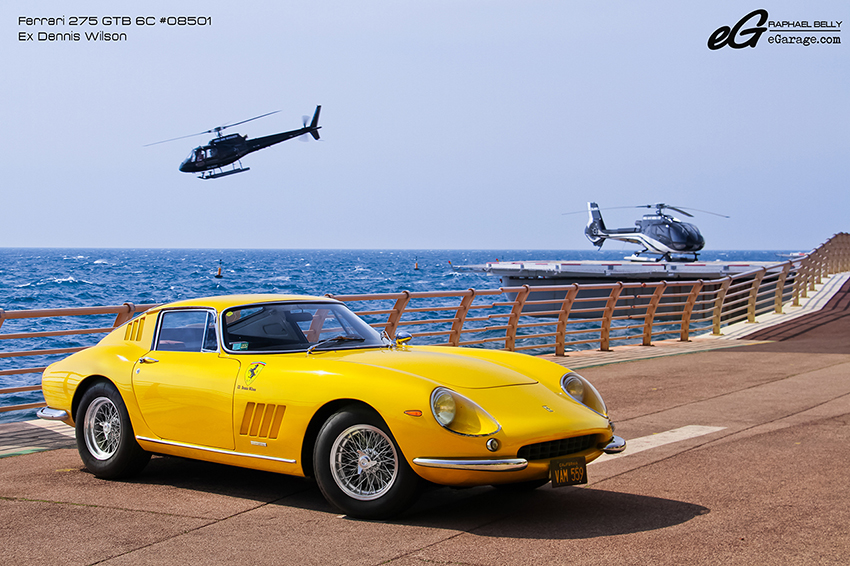
At the beginning of my exchange with the owner, I did not think of writing an article around his cars as I wanted to concentrate only on the pictures. Then, after our discussions, I realized that he had many interesting things to say. eGarage is not just about the cars but about the people behind the cars.
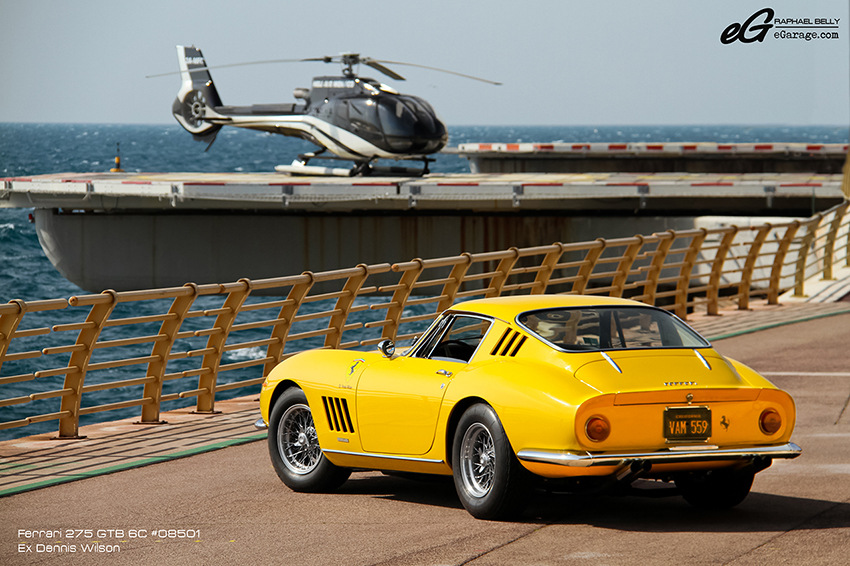
The goal was not to reveal his private life nor to be ostentatious, but I wish to present this article as a tribute, a tribute to this man full of kindness and passion who spent 40 years of his life to build this wonderful collection. Furthermore nowadays we tend to think about “this car costs so much” or “this collector owns this car” and we don’t look necessarily farther. I decided to point out the history of this man and his Ferraris, rather than to simply show the photos of each car.
It brings a soul to this history and it is also the opportunity for the owner to explain each car by presenting proofs, verifiable and irrefutable, available for consultation on the websites of each car.
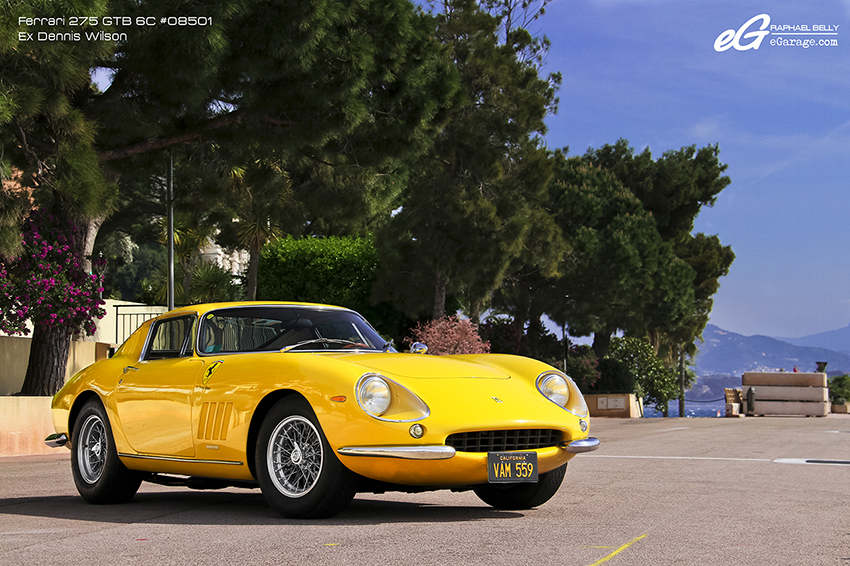
The Ferrari 275 GTB is a Berlinetta GT, front engine, produced by Ferrari between 1964 and 1968 around 740 units.
At the time, everything at Ferrari was not as simple as now; there was multiple versions within the same model, and the model in itself underwent numerous modifications in the course of its production. The “long nose” body already existed on the famed 250 GTO in 1962 and 1964. That’s why the first prototype of the 275 GTB (in February, 1963) was constructed with a long nose. On the other hand, the beginning of the 275 GTB production in 1964 only saw Maranello producing the GTB /2 Short Nose.
Ferrari thus decided to begin production only with the Short Nose. ”/2 ” indicates the presence of 2 camshafts (with 3 or 6 Weber carburetors), and Short Nose meaning the shortened front bonnet. The chassis was made of steel. The body could be steel or aluminium.
The Long Nose body was used on the 1962 250 GTO, but when the production of the 275 started, Ferrari preferred to use the Short Nose (to reduce the resistance to high speeds). So in 1963 and 1964 there was only 275 Short Nose. In 1965, Ferrari changed their mind and put the Long Nose back on the 275.
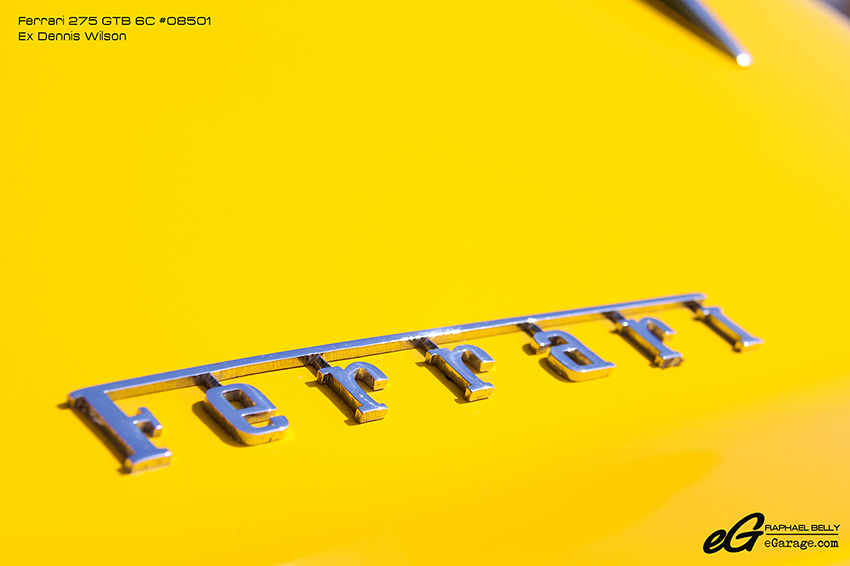
In 1966 the Ferrari 275 GTB /4 is introduced with the ”/4 ” signifying the change to 4 camshafts. It becomes available from then in Long Nose only, with 6 Weber carburetors, with a steel or aluminium body. The 275 GTB /4 of 1966 is recognizable by its light bump on the front bonnet (4 camshafts require more volume).
The first photos were of the Ferrari 275 GTB /2 (6 carburetors) Long Nose. The places to to take photos are not numerous in Monaco, you can count them on the fingers of one hand. Add to that the usual risks (parked cars, closed access to the place, etc.) and you will understand why I like to take photos on the famous main dike of the Port Hercule.
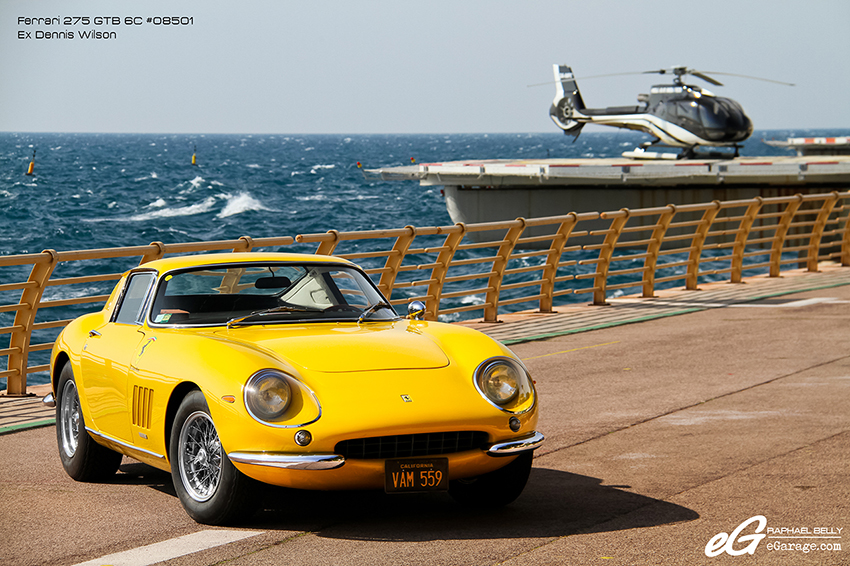
I thus decided to put the car near the Heliport in the district of Fontvieille, hoping to have some helicopters join us. And, we were rather lucky because the ballet of helicopters was ceaseless. The owner enjoyed himself and asked me regularly if I had had them in the photo with his car : “now, now take the picture there are copters behind ! It is good you had it ?”.
It was the opportunity for him to explain his history (of love) with Ferrari and the 275 GTB. “When I was young the car of my dreams was the Ferrari 275 GTB, it was a magnificent car which made me dream but I had no means to buy one to be honest. Even if the price did not reach the summits of the current time, it was still a Ferrari GT, thus extremely expensive .”

I wondered how this man had been able to become owner of these cars. However, I did not ask him his secret because it’s none of my business. But while I thought about that he immediately moved on by telling me this point, “As I did not have the means to buy one outright, I decided to search for a 275 GTB wrecked or in parts, to buy them cheaper, and to reconstruct it afterward to reach my dream; own one”.
But our man indicates me straightaway that he did not purchase to speculate : “I don’t care of the price or what the car’s worth, I had no objective to buy them to resell.”
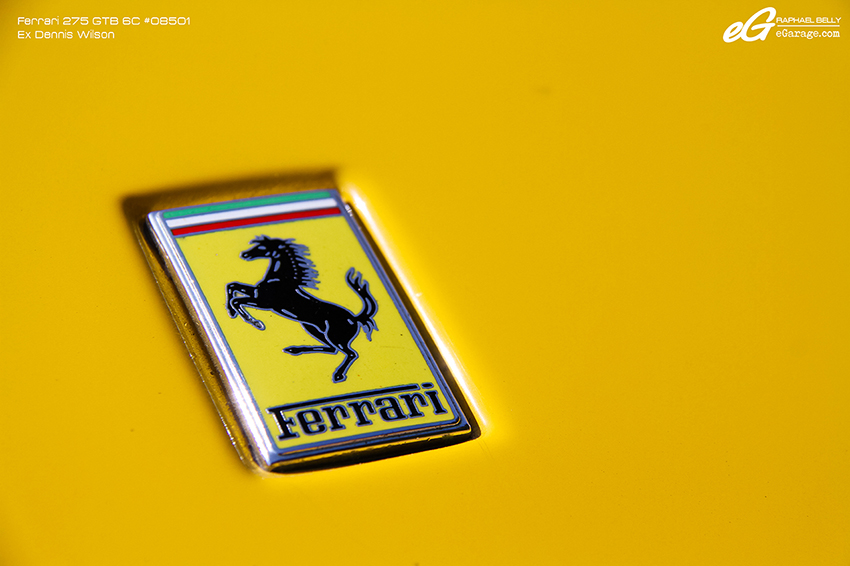
He spent 40 years of his life to buy, to restore, to investigate his cars : “I have always been fascinated by automobiles. I was a decorative painter in Monaco and I spent my holidays traveling the world in search of wrecks/parts cars. I went to Poland (to look for a Mercedes 540K abandoned by the German army in 1945), then to Greece, to the USA repeatedly, to collect car parts and information, and to meet the people connected to these cars.”
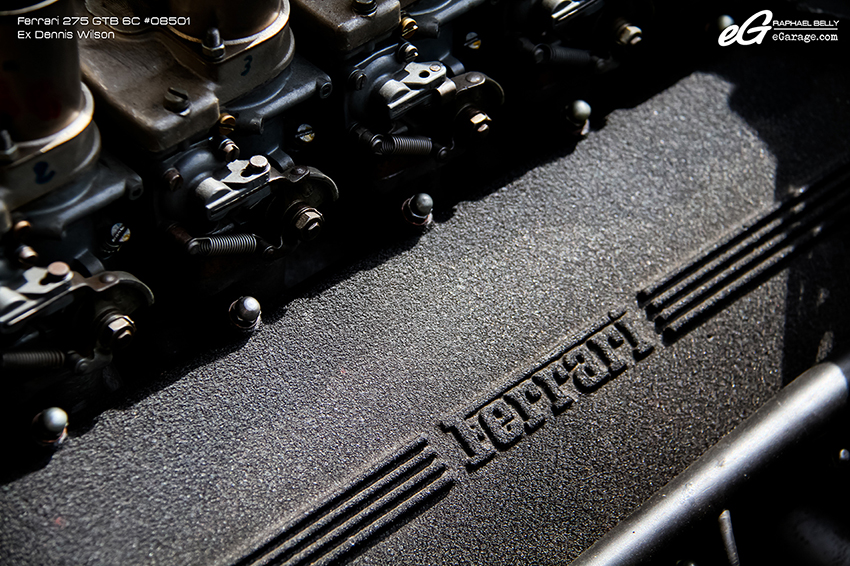
“When I was 10 years old in the 1960s, I spent time looking for abandoned motorcycles in barns, warehouses, etc. with a friend. One day by walking in a barn I was given a 500 DKW (which was unusual) coming from the German army. I brought it home and my father asked me ‘where did you get it?’. I had to say who had given it to me and my father went to meet him. This man hurried to reassure my father by telling him not to worry, that the motorcycle would never work because it has been almost 10 years since he got it working. My father thus let me tinker on this motorcycle. And two days later, he heard me on the motorcycle driving by. Two years later, I bought a 500 Terrot for almost nothing, it is still in the garage.”

He specified, “This one has an underestimated story.”
This wonderful 275 GTB /2, Long Nose, aluminum body, 6 carburetors, chassis #08501 was bought and owned by Dennis Wilson in 1967, drummer of the famous group The Beach Boys. It was grey back then.
At the beginning of 1968 Dennis Wilson and Beach Boys crossed a slack period. One day Dennis picked up two hitch-hikers, who turned out to be members of “The Family” – a movement of dozens of members established by Charles Manson in 1966. Charles Manson was an American criminal, whose movement was made famous by a series of murders in Los Angeles in 1969 and in particular, Sharon Tate in August 1969, who was Roman Polanski’s wife. Dennis spent the night with both hitch-hikers at his home in Los Angeles and then got acquainted with Charles Manson. And they became friends, and the whole Family with Charles Manson, settled down in Dennis Wilson’s residence.

In the brothers Wilson’s home, Brian and Dennis, at the beginning of 1968 there was three 275 GTB : this Ferrari 275 GTB /2 6C #08501 (which was then grey) Californian plate VAM 559, another Ferrari 275 GTB /2 6C #08743 (which was grey also before being repainted red) which belonged to Brian with Californian plate TVR 872. Finally, a red 275 GTB /4. Brian Wilson’s Ferrari 275 GTB /2 6C #08743, was borrowed by members of “The Family” and had an accident in Los Angeles. The front and the back were damaged.
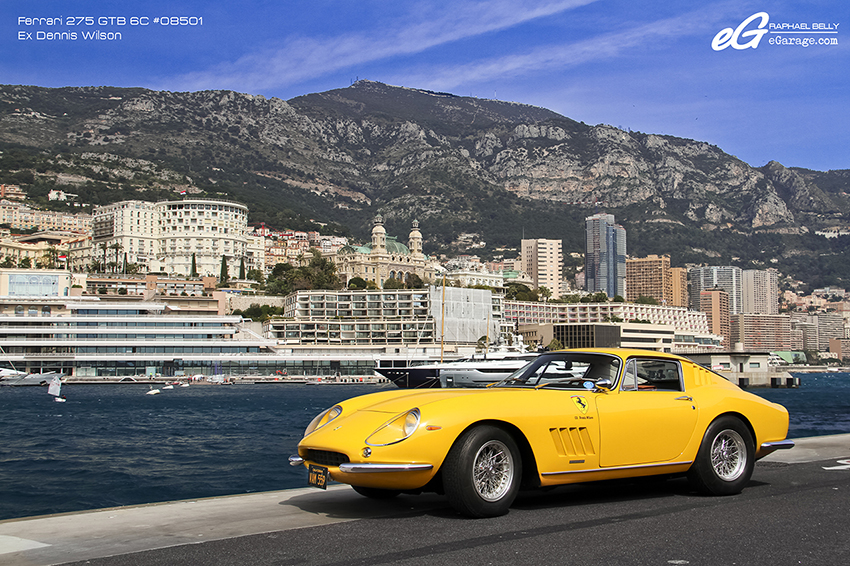
“The Family” stayed a few times in the Wilson brothers house and this ended in 1968. Then, all the members settled down in famous Spahn Movie Ranch of Los Angeles (a ranch created to be used as film set and television).
During summer, 1968, Dennis Wilson went to Spahn Movie Ranch with the 275 GTB #08501 to train and play music. This time another member of “The Family”, Steven Grogan, known as “Tufts Clem” and Charles Denton Watson “Tex” borrowed Dennis’s car, and they had an accident with it. The next day “Clem” and “Tex” claimed they had a narrow escape and that the car had made two flips, they managed to exit from the car through the passenger window. The car had big damage : hood, bumpers, wings, the roof, and in the back. Only the trunk lid, the back wing and the right passenger door remained saved at the body level, the engine and the chassis too.
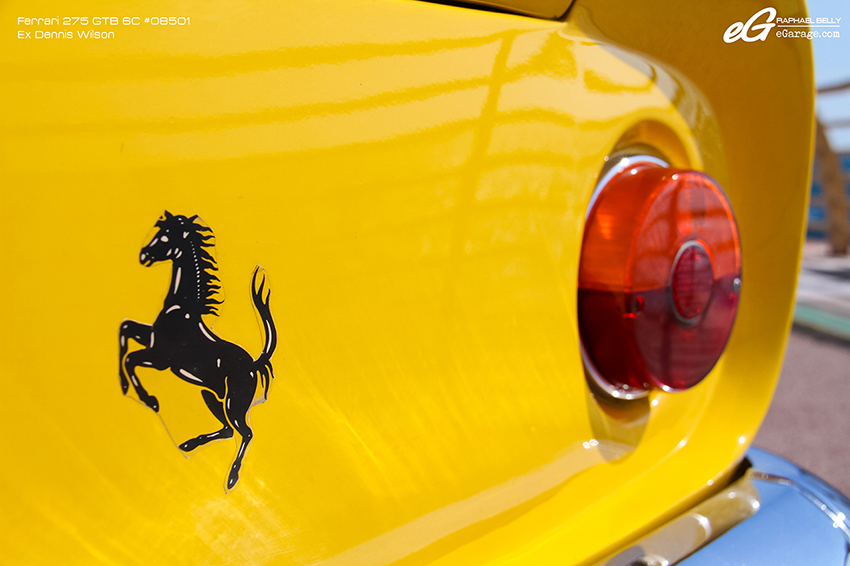
The wrecked car was then put on sale in Hollywood Sport Car Garage in Los Angeles. In 2002, our dear current owner acquired it, totally restored it, and painted in yellow.
For more details make sure you to visit the site completely dedicated to the car: http://www.ferrari275gtbc.com/index.html
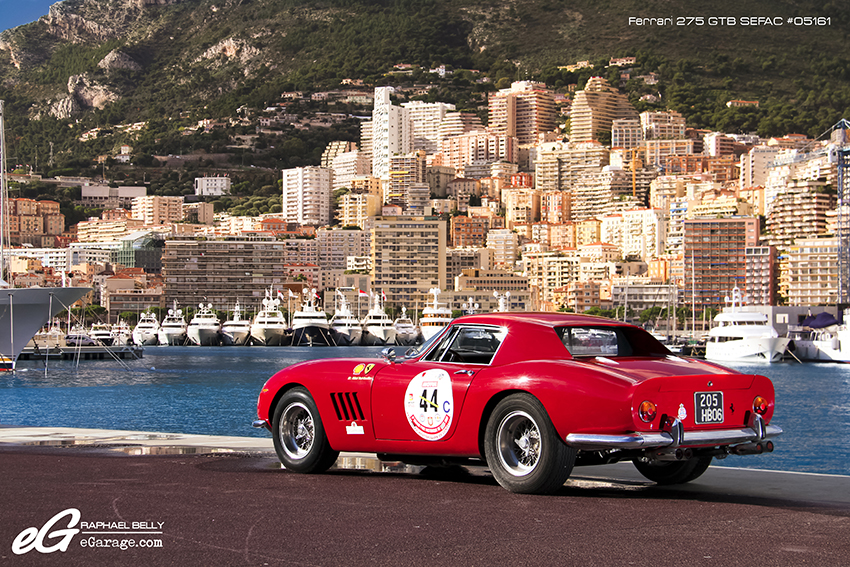
Let us cross from the yellow to the red with the second Ferrari 275 GTB, and the first one of the special versions : Ferrari 275 GTB S.E.F.A.C #05161. This 275 GTB seems standard at first sight but if you look more carefully (at the back especially) you will see that it is very special.
I saw this 275 GTB S.E.F.A.C for the first time in 2010, during the Monaco Telethon (a charity event with ride in Supercars). At the first look I believed it to be a Ferrari 275 GTB but two things intrigued me : the air inlet on the hood (neither the 275 GTB /2 or 275 GTB /4, or even 275 GTB /C has a stock air inlet), and this rear so particularly reminding me of the 250 GTO (Serie II, so called the 1962 250 GTO).
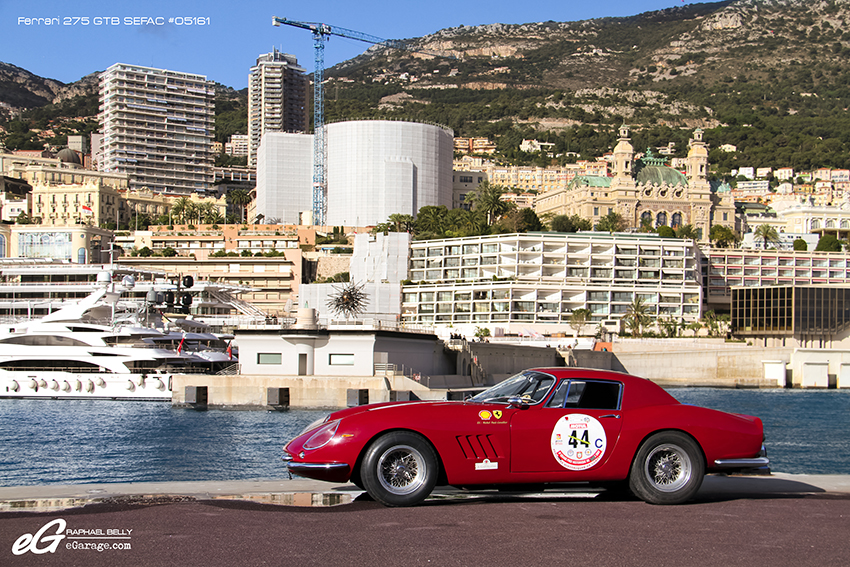
Within Scuderia Ferrari, a special department was created on May 23rd, 1960 : the S.E.F.A.C (Societa Esercizio Fabbriche Automobili e Corse). Michel Paul Cavallier (an important French industrialist, a CEO of factories Pont à Mousson) mobilized his stockholders’ equity and becomes an administrator at Enzo Ferrari’s side. Michel Paul Cavallier often went to Maranello to Ferrari for numerous meetings, with the engineers from Ferrari and Enzo Ferrari, and they discussed many special projects. He took part himself in the origin and elaboration of the famous 4 cylindered engine Facel Vega which was extracted from the famous Talbot 6. He is at the origin of the famous gear-boxes called Pont-à-Musson.
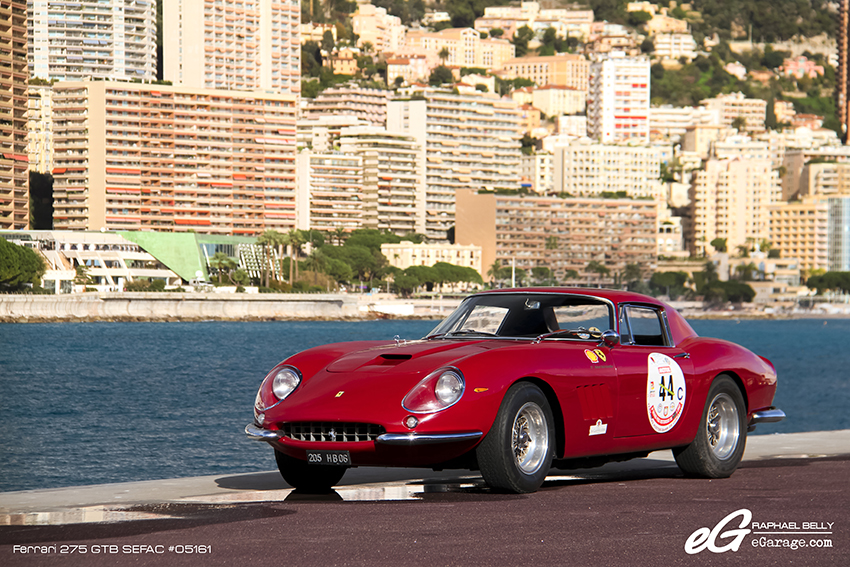
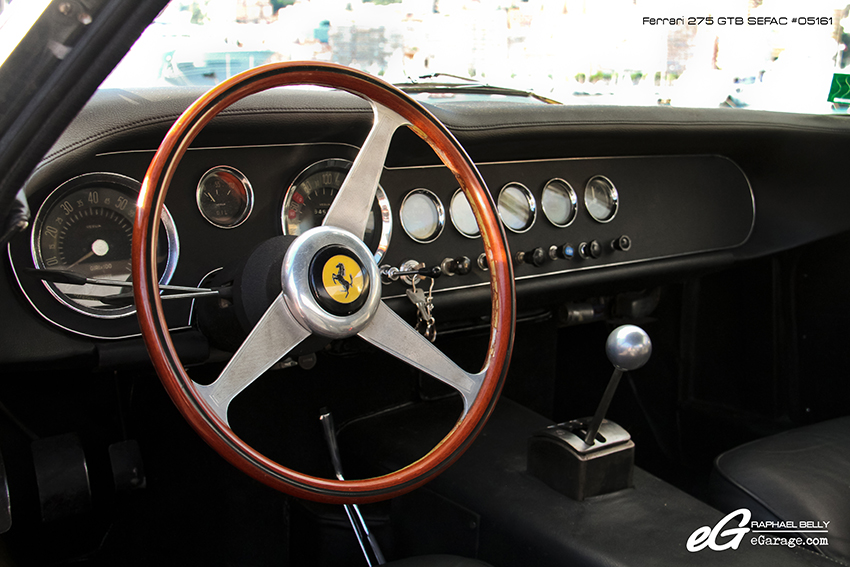
Among these projects, they decided to create the first prototype of Ferrari 275 GTB : a car on the 250 GT Lusso basis (chassis and engine, and prototype body of the 1964 250 GTO). The 275 GTB S.E.F.A.C #05161 had been born. It was delivered on March 23rd 1963 while the 275 GTB production series was to begin at the end of 1964. This Ferrari 275 GTB S.E.F.A.C #05161 is thus the Prototype of the production series 275 GTB produced later. Its body is aluminum and it adopts a Long Nose body.
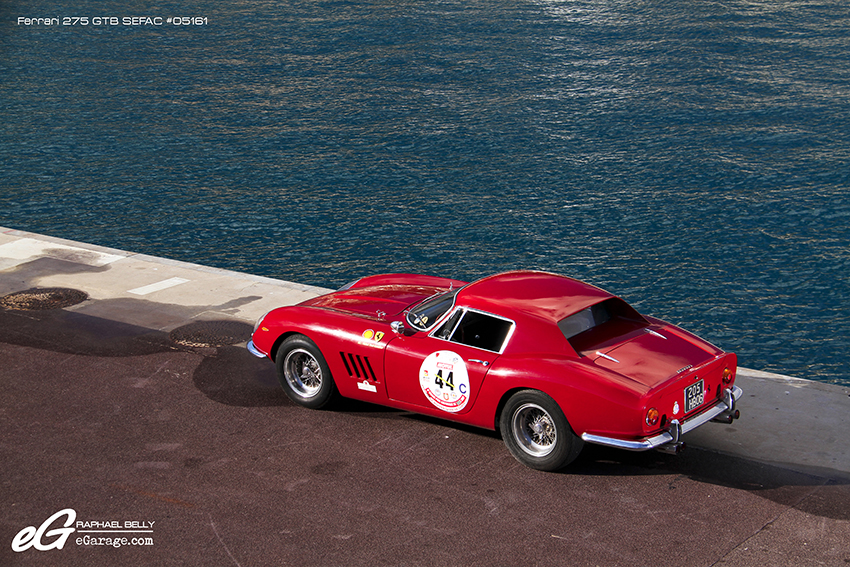
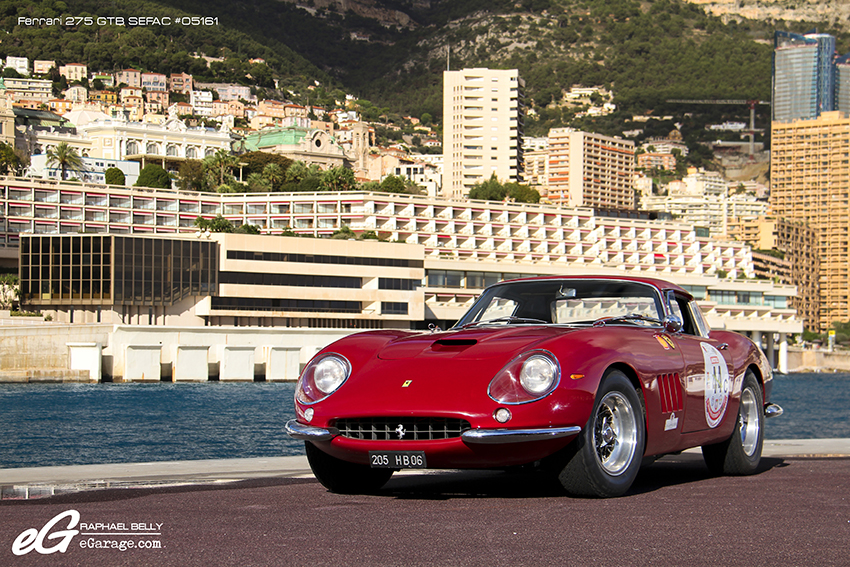
Unfortunately the S.E.F.A.C will be damaged in 1963 on the Fiorano test track and will be given up to Michel Paul Cavallier who kept it until his death at the end of 1964. After his death it was sold to colonel Dick Mitchell and left for the United States in 1965, where it was converted into Spider, to return finally back to France in the 1990 when it was restored in its original configuration.
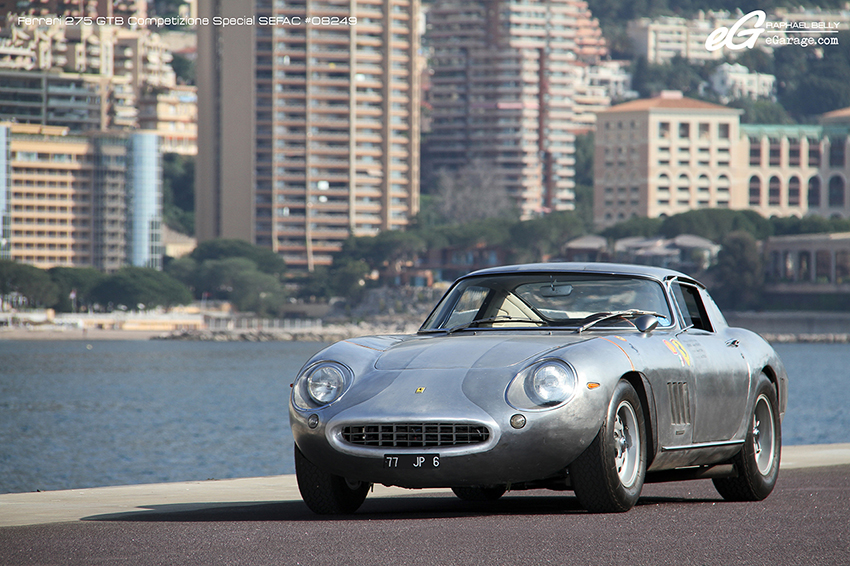
Let’s continue with the special models – the third and last 275 GTB of the collection of our passionate friend : the Ferrari 275 GTB Competizione Speciale S.E.F.A.C. #08249. A Long Nose, 3 carburetors, aluminum body.
The red 275 GTB S.E.F.A.C #05161 which we spoke about before was the first project of the Societa Esercizio Fabbriche Automobili e Corse. After the death of Michel Paul Cavallier, a second and last project was born on February 14th, 1966 : the Ferrari 275 GTB Competizione Speciale S.E.F.A.C.
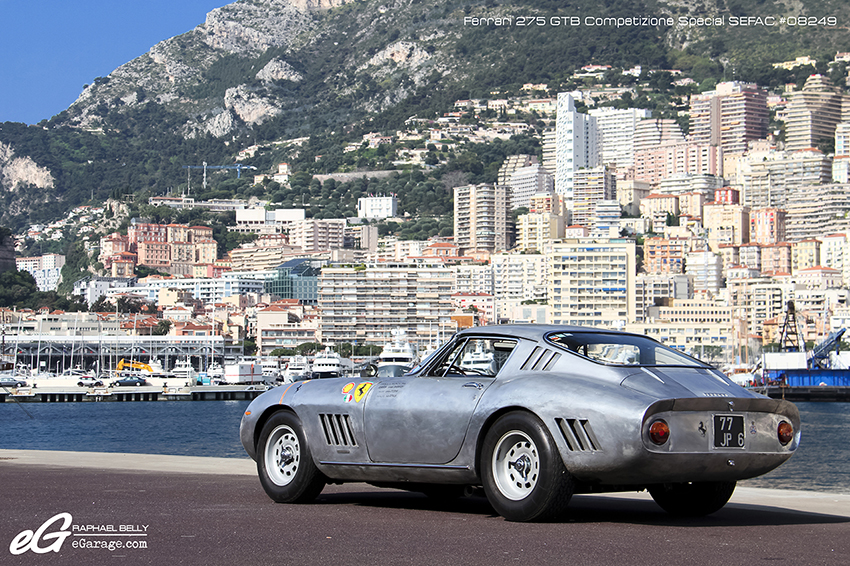
At the end of 1964, the 250 GTO competition is over and Ferrari tried replace them. To promote the 275 GTB which were produced since the beginning of 1964, Ferrari decides (through the S.E.F.A.C.) to produce some 275 GTB Competizione Speciale which carry the chassis numbers #06701, #06885, #07185, etc. and our Ferrari 275 GTB Competizione Speciale S.E.F.A.C. #08249 presented here. It’s not officially a Speciale but it has a lot of common features with the 3 Speciale cars.
This car is the result of a special order introduced by the Milanese Edoardo Spreafico for his friend Lorenzo Bandini to drive the 1000 kilometers of Monza of 1966. Much work was required to meet the needs of Lorenzo Bandini, light manufacturing for the race and all the latest technologies of this time, all to make the car look as a production 275. But at the beginning of 1966, Ferrari changed his mind for 1000 km of MONZA and decided to make Lorenzo Bandini run the Dino 206S number 852, and the Spreafico team with Giovanni Pessina and Piero Botalla racing in the 275 GTB Competizione Speciale #08249.

After having acquired the car on April 26th 2004, the owner evaluated 1 year later in April 2005 by the Institute of Soudure (IS), the company which evaluated the Concorde after its crash, to prove that the car was built as it stands by origin and in particular that : the lightening structure was made at the same time as the construction of the car, that it was conceived with a dry oilpan, that the body was neither unsettled, nor changed, and finally that the mechanics are completely original.
The 275 GTB Competizione Speciale each have their peculiarities but all have in common the following : a very thin aluminum body, a light steel and aluminum structure offering a reduced weight from 150 to 200 kg compared with the standard 275 GTB, and they are all equipped with a ribbed engine (as the one of the 250 LM) containing 4 points of attachment, as well as of numerous characteristics of competition : removable trapdoor for the fast access to the clutch, the side exhausts, etc.
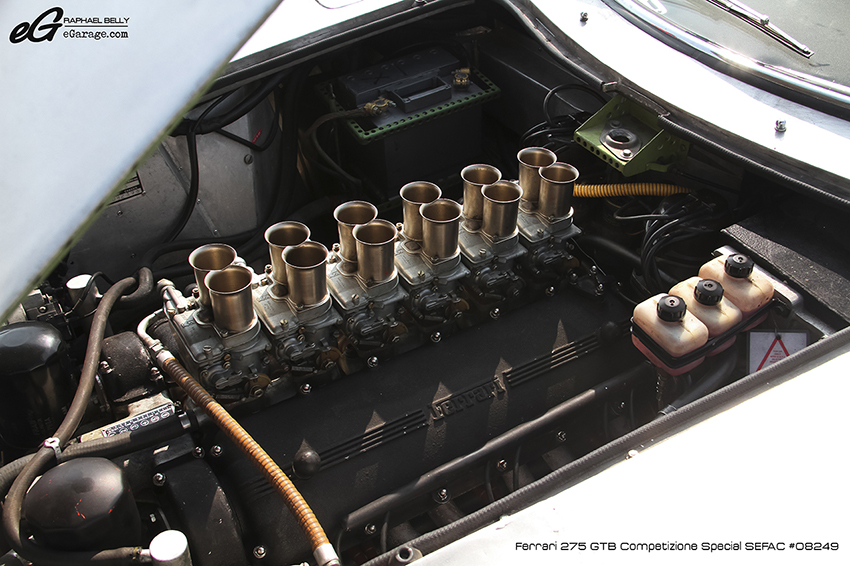
That’s why at first sight it can seem “damaged” due to its dented body. But by having in mind its story and this unique body you will understand why it stays like that “in its juice”, to replace it with a new body could be more elegant for some but it would be a big mistake and regrettable. Over and above the fact that even in case of restoration nowadays we realize no more bodies are so thin.
When we were on the dike of the Monaco Hercule Port taking photos we had to move the car for various shots. To avoid having turning the engine on and off, we leave it in neutral and the owner indicates me that we are going to push it (it’s very light : 800 kg!). I get ready to help the owner to push when he launches to me “Oh not there! Help me to push here (indicating me a precise place on the back wings). If you push there (in the place where I planned to push first of all) the body risks to sink because it is 1mm of thickness”. He confided me that it was regularly necessary to straighten the body which moves over time and of the use. It is really someone who knows the his cars as if it was a part of himself, it is really impressive and praiseworthy. Moreover, when we set the photography session, he admitted to me having spent 2 hours the day before to pamper it and to prepare it: “I spent the evening to add some oil, to check if everything worked well at the mechanical level, to control everything and I hand washed it.”. “You know it is not a car that only needs to turn the key and it starts!” He adds, smiling.
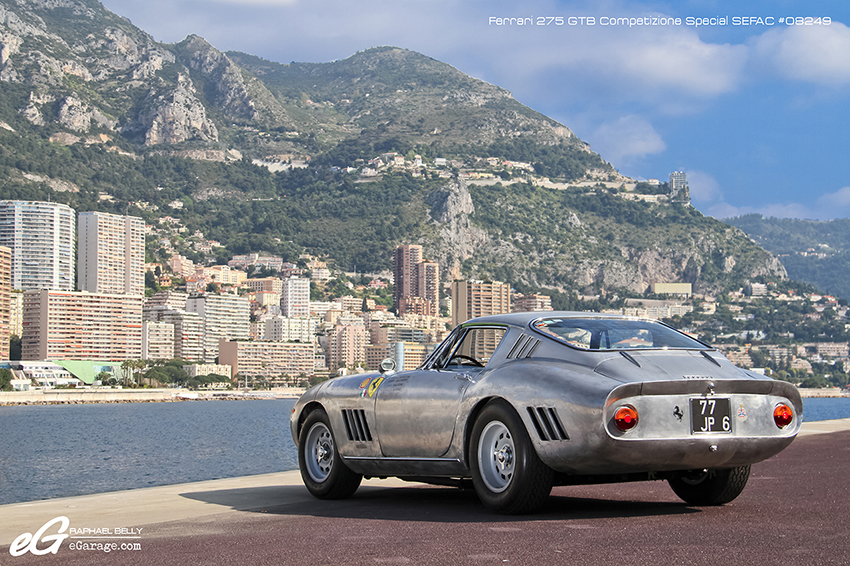
Many people were jogging by. They stopped to take photos and to ask about the car and its age. Among them, a woman started to speak with our man, and according to the discussion she was able to realize all the passion which lives within our owner : “I feel your fascination. It seems obvious and even more when I look at you and the car – you are linked and you appear well magnificently together. I feel that there is a history between you and a real soul comes from the car and you.”
As the previous special project of the Societa Esercizio Fabbriche Automobili e Corse, the creation of the 275 GTB Competizione Speciale was not in vain because the few Speciale produced between 1965 and February 14th, 1966 (the last one produced : #08249), served as the basis to the 275 GTB /C (Competitzione) which was produced in 1966.
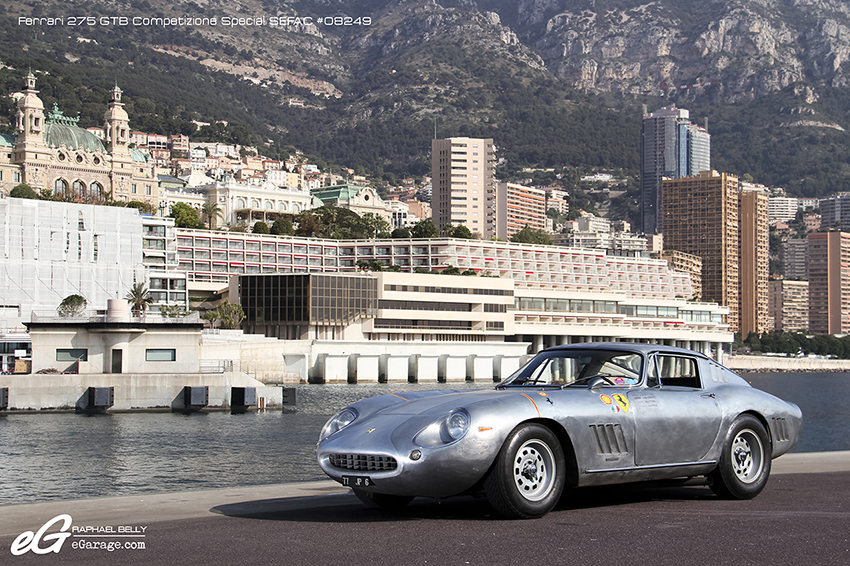
Delivered on February 14th, 1966, the 275 GTB Competizione Speciale S.E.F.A.C. #08249 raced the Coppa FISA de Monza. And then to the 1000 km of Monza April 25th 1966, driven by Giovanni Pessina and Piero Botalla. During the race, it underwent a superheating engine because of the power of the V12 3,3L. The mechanics decided to cut the top of the radiator trim by hand (to aerate the engine), the same way they had made it on the 275 GTB Competizione Speciale #6885 at the 24 hours of Le Mans. During 1000 km of Monza in 1966 it underwent damage in front and back when it collided with the 2nd Ferrari 275 GTB #06785, causing it invaluable minutes in repair. In anticipation of the 50th Targa Florio in 1966, it was sent to Maranello in May 1966 for repair from the accident in Monza. Afterward, front night lights were added, as well as ventilation gills in the back wings.
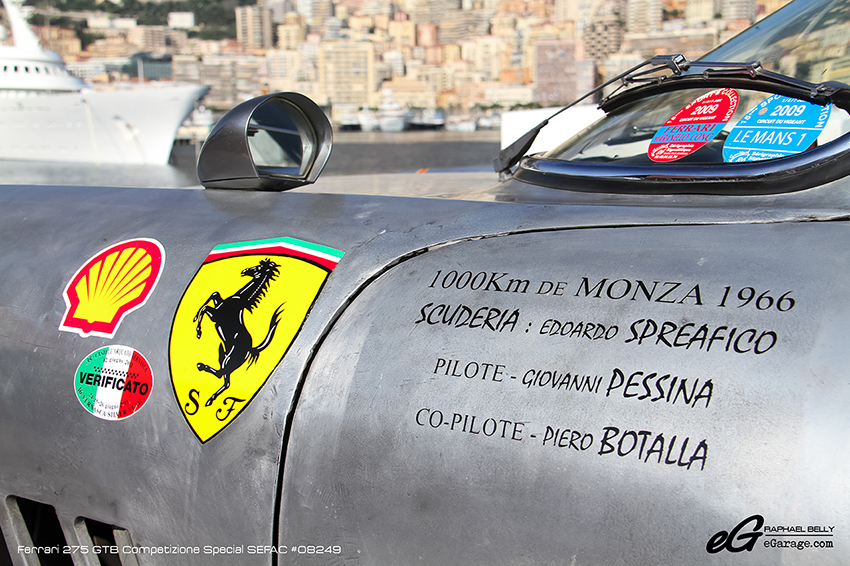
In January, 1967 it was sent again to Ferrari in Maranello to meet driving regulations for road use. At the end of January, 1967 to 1973 it changed several hands in Italy and was exported to the United States in July 1973 where she was supposed to race Daytona via Jim McRoberts.
It was taken apart entirely with the goal to be restored, but the project never succeeded. On July 21 1980, it was resold to the United Kingdom but during its transport from the United States to the United Kingdom it was damaged in its container. It was offered by Bonhams auction on April 28th, 2004 in the form of a “Basket Case” with all the dismantled parts. This is when our man acquired the car. “When I bought the car I have to admit that it was a stretch financially, but I wanted it, and did not think. My wife treated me as madman but she said to me, “we will manage”. To pay for it I had to sell my completely restored 250 GT Lusso”.
For more details make sure you to visit the site which is completely dedicated to the car : http://www.ferrari275gtbcompetition.com
Owning such cars is not an easy thing. The first thing is to have parking enough to store 3 collectible cars, a hard thing in Monaco and its neighborhoods. Then you have to start them and to drive them : without safety belts because in the years 1960-1970 it was not compulsory. In the case of the 275 GTB Competizione Speciale S.E.F.A.C. #08249, it is a racing car so was not made for the road.
Once at the wheel, one must manage to maneuver in the dense traffic of the South of France. With these cars, we do not speak about power steering or about parking aids etc. One must fight with the steering wheel to turn, all while having greatly reduced visibility. But all this is a part of the charm and the philosophy of a classic car, in the same way as the smell of the old leather on board, the raw metal, the gas and the exhaust, and the sound of the engine for a radio. Even after years of ownership, our man is still amazed in the Monegasque tunnels, “You hear that! What an engine! It is fantastic.”

They tickle the ears and attract the glances : heads turn around, cameras unsheathe. Our man is always available to answer the questions of the passers-by, intrigued.
All these details around these cars testify to a certain fragility. Fragility not because the cars were badly conceived or built, but fragility because you have to pay attention to everything : the type of garment which you wear, not to crack the old leather, trying to protect the mechanics by putting the car in neutral, avoiding the repeated stop & start, etc.
But it is not so complicated as underlines the owner : “honestly it is rather simple to drive these cars, it is rather flexible”. But, I realize why these kind of cars stay in garages. And I realize even more the luck I have to see ones wildly in the street, as well having seen them racing during motor events such as Historic Grand Prix of Monaco, the Tour Automobile, The 10000 Tours, etc.
At the end of this adventure, I would like to thank the owner for his patience, his kindness, confidence, and his availability throughout.